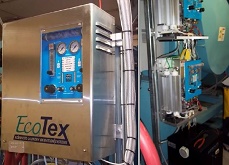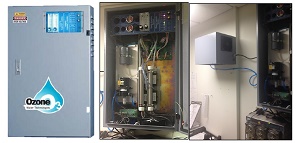WASHINGTON, D.C.—Those looking for assurance that ozone laundry technology does indeed reduce energy, water and related costs can find proof in study results recently released by the U.S. Department of Energy (D.O.E.) Building Technologies Office. The D.O.E., with the assistance of outside consultants, conducted a demonstration project to evaluate ozone laundry technologies for reducing the energy and water use of multi-load washers in healthcare and hospitality facilities.
The D.O.E. report, entitled, “Demonstration of Advanced Technologies for Multi-Load Washers in Hospitality and Healthcare—Ozone Based Laundry Systems,” documents the demonstration of two ozone laundry system installations. The first installation took place at the Charleston Place Hotel in Charleston, S.C. and incorporated a system from ClearWater Tech, LLC, San Luis Obispo, Calif. The second installation, by Ozone Water Technologies, Inc., Tryon, N.C., took place at Rogerson House, an assisted living facility in Boston.
The Charleston Place Hotel laundry facility consists of three Braun 250-pound multi-load washers and one Washex 90-pound multi-load washer. The hot water for the clothes washers is heated by a natural gas boiler with a nominal thermal efficiency of 75 percent. The ozone system used at the Charleston Place Hotel, which has 320 deluxe rooms, 80 club-level rooms, and 40 suites, was the Eco3Tex system from ClearWater Tech. The system consisted of three ECO2 ozone generators and one ECO1 ozone generator. These were paired with two AEROUS-8 oxygen concentrators. The three ECO2 ozone generators serviced the three Braun washers and the ECO1 ozone generator serviced the Washex washer. The ozone was pumped through tubes leading to the back side of the washers. The system was in continuous operation during each wash and rinse cycle. A controlled connection to each washer instructed the ozone generator when to feed ozone into the washer.
Numerous Adjustments Necessary
 Immediately after installation of the ozone system, the ozone installer adjusted the pre-programmed wash cycles to be compatible with the new ozone system. The wash cycles were reprogrammed to use all or mostly cold water, and the detergent quantities were reduced to prevent over-sudsing under the new wash conditions.
Immediately after installation of the ozone system, the ozone installer adjusted the pre-programmed wash cycles to be compatible with the new ozone system. The wash cycles were reprogrammed to use all or mostly cold water, and the detergent quantities were reduced to prevent over-sudsing under the new wash conditions.
During the next few weeks, the on-site laundry staff provided feedback regarding the observed performance (cleanliness/operation) under the new system. The staff mentioned that ozone was neutralizing the characteristic scent from the hotel’s fabric softener. Based on this feedback, the washers were further adjusted so that an ozone injection was eliminated from the cycle that uses the fabric softener.
After these final adjustments, the laundry staff was satisfied that all the various types of laundry loads were being washed as effectively as they were before the ozone system was installed. The post-ozone monitoring period began after the final wash program adjustments were made.
Rogerson House is an assisted living facility in Boston offering full-time residence, a day program, and respite care for people with memory loss and Alzheimer’s disease. The assisted living facility accommodates up to 66 overnight residents. The Rogerson House laundry facility consists of two UniMac multi-load washers, each with a clothing capacity of 60 pounds. The hot water for the clothes washers is heated by a natural gas boiler with a nominal thermal efficiency of 80 percent. The laundry chemicals are located in a separate room adjacent to the laundry room. Peristaltic pumps are used to pump the chemicals through tubes leading up into the ceiling and over into the adjacent laundry room.
Setup of Ozone System at Rogerson House
The ozone system used at the Rogerson House was the LaundrOzone system from Ozone Water Technologies. The system consisted of two wall-mounted boxes: one containing the ozone generation equipment and the other containing a single compressor. The ozone generation box uses a modular design, which can accommodate up to four sets of ozone equipment (one for each washer connected to the system). Due to space constraints in the laundry room itself, the ozone system was installed in the adjacent room with the laundry chemicals. The ozone was pumped through a tube leading up into the ceiling and over into the adjacent laundry room. With the LaundrOzone system, the ozone is injected directly into the sump part of the clothes washer. The system was in continuous operation during each wash and rinse cycle. A controlled connection to each washer instructed the ozone generator when to feed ozone into the washer.
 Immediately after installation of the ozone system, the ozone vendor worked with the detergent chemical supplier to modify the pre-programmed wash cycles to be compatible with the new ozone system. The wash cycles were switched to cold water only, and the detergent quantities were reduced to prevent over-sudsing under the new wash conditions.
Immediately after installation of the ozone system, the ozone vendor worked with the detergent chemical supplier to modify the pre-programmed wash cycles to be compatible with the new ozone system. The wash cycles were switched to cold water only, and the detergent quantities were reduced to prevent over-sudsing under the new wash conditions.
During the next few weeks, the on-site laundry staff provided feedback regarding the observed performance results under the new system. The staff mentioned that a few of the wash programs—specifically, those involving bleach—were not removing stains as well as they had been before the installation of the ozone system. Based on this feedback, the heavy wash programs that use bleach were further adjusted until satisfactory cleaning performance was achieved. After these final adjustments, the laundry staff was satisfied that all the various types of laundry loads were being washed as effectively as they were before the ozone system was installed. The post-ozone monitoring period began after the final wash program adjustments were made.
Significant Testing Period
At the Charleston Hotel, the team collected baseline data on the existing laundry equipment for a period of 48 days. The team then collected data for a period of 35 days following the installation of the ozone laundry system. At the Rogerson House, the team collected baseline data on the existing laundry equipment for a period of five weeks. The team then collected data for a period of seven weeks following the installation of the ozone laundry system.
Complete study results can be found in the report. Briefly, the ozone system installed at Charleston Place Hotel delivered significant water heater energy savings of 65 percent. The ozone system resulted in a decrease in total water consumption of 15 percent. The simple payback period for this ozone system installation is 2.8 years. The ozone system installed at Rogerson House delivered significant water heater energy savings of 63 percent. The ozone system resulted in an increase in total water consumption of 19 percent. According to the report, the increase in water consumption was a result of the changes that were made to the wash cycle programs during the initial setup period in order to maintain satisfactory cleaning results after installation of the ozone system. Jim Gross, President and CEO, Ozone Water Technologies, told Green Lodging News that a different choice of water chemistry would have resulted in significant water savings at Rogerson House. The study found the ozone system at Rogerson House did not offer a financial payback in its current configuration due to the net increase in water consumption and the relatively low throughput of the system.
The report concludes by making recommendations to help advance the adoption rate of ozone laundry technology. Among the recommendations: encouraging the adoption of modified business models for chemical suppliers (to alleviate the inherent risk to their business that the ozone system presents); greater collaboration between ozone system manufacturers and washer manufacturers; and more careful attention to total water consumption during the reprogramming of the wash cycles.
Click here to access the report entitled, “Demonstration of Advanced Technologies for Multi-Load Washers in Hospitality and Healthcare—Ozone Based Laundry Systems.”
Glenn Hasek can be reached at editor@greenlodgingnews.com.





